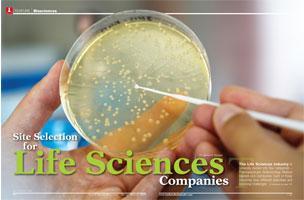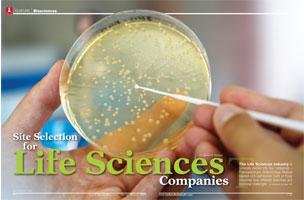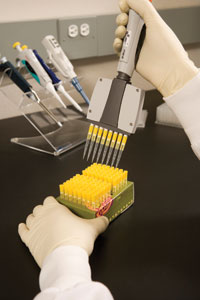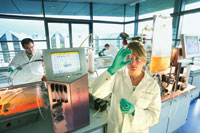

The Life Sciences industry is generally divided into four categories – Pharmaceuticals, Biotechnology, Medical Devices and Distribution. Each of these industries have different objectives and locational challenges:
Pharmaceuticals have their roots in the historic use of plants and minerals for medicinal purposes. Today, the bulk of pharmaceutical industry profits are derived from a broad-based list of compounds used to treat infections, cardiovascular conditions, depression, inflammatory disease and other chronic conditions.
Biotechnology commonly refers to the application of biological and biochemical science to large-scale production, for the purpose of modifying human health, food supplies or the environment. Often focus is only on the discovery and development of drugs based on cellular approaches. The biotechnology industry today comprises many different practices, which some (but not all) involve the alteration of genetic material.
Medical Device companies typically focus on the research, development, manufacturing and marketing of equipment related to the diagnosis and/or treatment of a wide variety of ailments. Three of the most common product areas include:
Diagnostic equipment (such as blood analyzers)
Cardiovascular devices (such as stents, defibrillators, pacemakers, catheters, heart valves and connectors)
Orthopedic/reconstructive products (such as replacement joints and reconstructive implants).
 The Tufts Center for the Study of Drug Development (CSDD) recently reported that it costs $802 million, on average, to develop and win market approval for a new drug in the United States. Discovery and preclinical trials take anywhere from one to fours years of work and cost up to $200 million, before Phase I trials begin. Once a product survives to Phase I, it can cost up to $500 million before products are proven on animal and human patients and take six to eight years. Finally FDA approval and post-market testing can run the average cost of bringing a new product to market to over $800 million and 14 to 16 years from inception.
The Tufts Center for the Study of Drug Development (CSDD) recently reported that it costs $802 million, on average, to develop and win market approval for a new drug in the United States. Discovery and preclinical trials take anywhere from one to fours years of work and cost up to $200 million, before Phase I trials begin. Once a product survives to Phase I, it can cost up to $500 million before products are proven on animal and human patients and take six to eight years. Finally FDA approval and post-market testing can run the average cost of bringing a new product to market to over $800 million and 14 to 16 years from inception.
Industry Challenges
Each segment of the industry faces unique challenges which dictate very different locational strategies.
Pharmaceutical companies face the following issues:
Margin pressures (low-cost country sourcing)
Excess manufacturing capacity
Un-reconciled post-acquisition/merger operations
Competition from contract manufacturers
Shift to low-volume high-value targeted products
Weak pipeline for new products
Emergence of generics
Recent manufacturing quality issues
 Biotechnology companies face a completely different set of challenges:
Biotechnology companies face a completely different set of challenges:
Increasing margin pressures (global effective tax rate)
Manufacturing capacity for “blockbuster” products
Risk mitigation
Access to emerging markets
Weak pipeline for new products
Emergence of biogenerics in Europe
Competition from low-cost manufacturers
Site Selection Factors
In each stage of this process, different site selection factors predominate. For example, during the R&D stage of drug development, the focus is on accessibility to venture capital, the presence of other R&D stage companies in the area, the availability of researchers with unique skills, knowledge and talents, and the ability of a location to attract the best and brightest in the world. At this stage, costs are not as important as access to capital and talent.
 In the clinical trial stage, biotech companies may be more interested in having access to sophisticated medical research facilities, talent pools and trial populations.
In the clinical trial stage, biotech companies may be more interested in having access to sophisticated medical research facilities, talent pools and trial populations.
During the manufacturing phase, companies become more interested in cost control and access to sophisticated biotech production labor. In this phase, capital cost minimization, incentives, labor costs and taxes become important site selection criteria. Many biotech companies will outsource the production of biotech products to companies that specialize in production and have selected facilities locations to optimize these criteria.
Finally, in the distribution phase, location drivers become more focused on proximity to customers, business disruption risk control and operating expenses. Here incentives and transportation infrastructure assume a greater degree of importance in the site selection process.
What to Look For
Biotechnology companies looking to invest in a community should consider the following factors:
Access to venture capital
Skilled labor pool
Culture of innovation
Quality of Life
Availability of resources/support
Accessibility
Regulatory environment
Capital costs
Labor costs
Utility costs
Cost of living
Tax environment
Business disruption risk
Incentives
There are a variety of state and local incentives available to life sciences firms depending on the geographic location, type of operation, investment, employment, and tax impact of the company’s facilities. Such incentives include tax rebates, exemptions, moratoriums, reductions, credits, deductions, infrastructure improvements, relocation, and cash grants, which can be used to offset both start-up costs as well as the cost of ongoing operations.
Total benefits provided to a company in a given region can range from a low of several thousand dollars per employee to cases in which employers have been offered incentives packages that amounted to millions of dollars per employee. Whether a company will be on the lower or higher end of this range – and whether available incentives are collected at all – will depend to a large extent on the knowledge and skill a company brings to the negotiating table.
The Incentives Management Process According to studies done by Professors Alan Peters and Peter Fischer, a total of $48.8 billion dollars is spent annually on state and local incentives to attract new investment, jobs and tax dollars. Yet many executives feel that their companies are not maximizing their utilization of these benefits.
According to studies done by Professors Alan Peters and Peter Fischer, a total of $48.8 billion dollars is spent annually on state and local incentives to attract new investment, jobs and tax dollars. Yet many executives feel that their companies are not maximizing their utilization of these benefits.
In identifying the reasons that their companies fail to take advantage of all available credits and incentives, a study showed that only 4 percent of respondents said the failure was due to poor negotiation. More than 81 percent attributed the lack of efficiency in this area to the absence of a formal process for identifying and securing incentives and credits, as well as poor tracking of compliance requirements after incentive programs are negotiated. Such a perception was verified by a study at Georgia State University, which found that only about 50 percent of all negotiated incentives are ever collected.
The information and approach that life sciences companies bring to the negotiating table is an important component in optimizing the amount of incentives attained by locating in a particular region. The best incentives negotiations start with a full understanding of what tools are available in the geographic area in which a company is interested. Although incentives cannot and should not be used to determine the best initial areas to look at when planning an expansion or relocation, it is important to introduce incentives discussions early in the evaluation of finalist communities.
Finalist communities should be informed that a company is looking at how incentives and available credits distinguish one finalist location from another. Many biotech companies do not have the background or objectivity necessary to maximize the use of available incentives and credits because they do not conduct such negotiations on a regular basis. Frequently companies reveal too much about their plans to state and local officials prior to making a final decision. Thus, they lose some or all of their leverage in final incentives negotiations.
In one recent example, a company’s senior vice president decided to circumvent the incentives negotiation process and negotiate with state and local officials on his own. Although the company ended up with almost $5,000 per employee in incentives benefits, the executive didn’t know that his biggest competitor had negotiated a deal worth almost $15,000 per employee. With more than 500 employees scheduled to be hired at the new facility, the failure to go through the incentives negotiation process cost the company and its shareholders more than $5 million.
Negotiating Based on Need
There is a broad range of possible incentives programs that may or may not apply to a company’s specific situation. The key to maximizing the use of these programs is knowing how the programs work and how they could affect a company’s operating and start-up costs. For example, many state programs offer job creation tax credit programs that provide a certain level of state tax credits – ranging from $500 to $31,500 per employee – based on the hiring of new personnel. Many of these programs have specific wage or benefits requirements that can preclude the use of these incentives without adequate knowledge of how they apply to a company’s specific situation.
 Moreover, if a life sciences company does not currently have a tax liability in the state in which it is considering locating and it is unlikely that the company will be generating liability in the near future, these job creation tax credit programs have little or no impact on the company’s financials. Too often, operations personnel get involved in negotiating incentives with little understanding of how the value of tax credits can affect various operating scenarios. By the time corporate tax accountants get involved in the analysis, there is little that can be done to salvage the incentives negotiations.
Moreover, if a life sciences company does not currently have a tax liability in the state in which it is considering locating and it is unlikely that the company will be generating liability in the near future, these job creation tax credit programs have little or no impact on the company’s financials. Too often, operations personnel get involved in negotiating incentives with little understanding of how the value of tax credits can affect various operating scenarios. By the time corporate tax accountants get involved in the analysis, there is little that can be done to salvage the incentives negotiations.
Capitalizing on Incentives
Many states and areas have identified the life sciences industry as a high-priority target for recruitment. Incentives in these regions can be quite lucrative. When Scripps Research Institute was looking for an East Coast home for its new research center, the state of Florida, led by Governor Bush, kicked in more than $450 million in incentives, including more than $300 million in grant funding and a free $140 million facility. According to Scripps, the facility will employ 545 workers by its seventh year of operation – an incentives/employment ratio of $826,000 per job.
Most incentive deals are not quite that lucrative, but still worth pursuing. When orthopedic device manufacturer, Zimmer, announced its desire to expand its facilities in Warsaw, IN, state and local governments obliged with more than $6 million in incentives – an incentives/employment ratio of $24,000 per employee.
Some states provide free training services to companies as a noncash incentive that improves the quality of the local labor force. The Gambro Group worked with the Alabama Industrial Development Training Institute (AIDT) to provide training to the 150 new employees that the company hired in Opelika, where 10 million Polyflux dialyzers will be produced annually in a new 100,000-sq-ft manufacturing facility. AIDT assisted with the hiring of Gambro’s first 13 employees in Opelika. The new hires were sent to Hechingen, Germany, to start 18 months of training.
Depending on the types of incentives programs that have been approved by legislatures, incentives vary greatly from one region to another. Total state and local assistance generally falls in the $10,000 to $40,000 per job range. For capital-intensive facilities, incentives can range from 10 to 30 percent of capital investment costs. However, the actual final incentives can vary markedly, depending on the types and proposed payroll of the jobs being created, the capital investment, the tax-generating potential of the project, and the level of competition for the new facility.
Targeting Incentives
Incentives programs should be tailored to address the key issues of the segments of the value chain targeted. Across all segments the underlying theme should focus on risk reduction. For example, R&D centers should focus on access to venture capital, provision of facilities – especially labs, relocation assistance, and recruiting and training assistance.
Manufacturing and distribution facilities should focus on areas that are more competitive and offer favorable state tax structure (single sales factor), capital cost subsidization/deferral, flexible local tax structures (property taxes), recruiting assistance, relocation assistance, industry specific training assistance, and fast track permitting.
Conclusion
There are billions of tax and financial benefits available to biotech companies who know how to access them and can put a process in place to collect them. The best way to start the process of maximizing incentives and credits is to conduct a confidential analysis of a prospective site location long before a final decision is made as to where a facility will ultimately locate.
 Knowledge and information are the keys to successful incentives negotiation. Smart companies come into negotiations with an understanding of exactly what programs are available, how they have been used in the past for similar projects, and how to best use them for the current project plan. Monitoring, maintenance and compliance are necessary to ensure that all of the benefits which the location decision was made are fully realized.
Knowledge and information are the keys to successful incentives negotiation. Smart companies come into negotiations with an understanding of exactly what programs are available, how they have been used in the past for similar projects, and how to best use them for the current project plan. Monitoring, maintenance and compliance are necessary to ensure that all of the benefits which the location decision was made are fully realized.
While incentives are often the tie-breaker between finalist locations, don’t make the entire location decision based on incentives alone. Many other factors should be considered prior to commencing incentives negotiations. Once these base requirements are satisfied, then productive and meaningful negotiations can begin.

